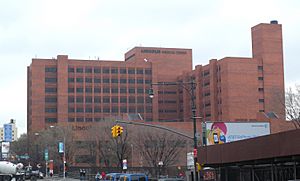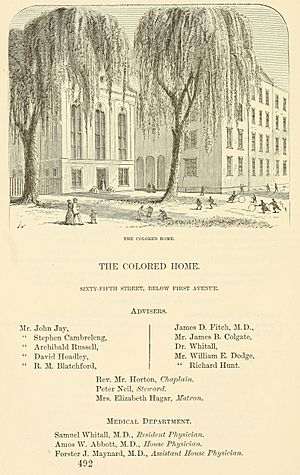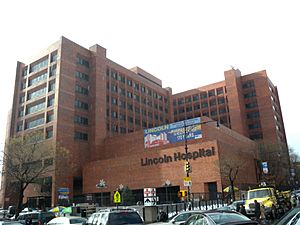Lincoln Hospital (Bronx) facts for kids
Quick facts for kids Lincoln Hospital |
|
|---|---|
| NYC Health + Hospitals | |
 |
|

A view of the hospital from East 149th Street
|
|
| Geography | |
| Location | 234 East 149th Street, The Bronx, New York, United States |
| Coordinates | 40°49′N 73°55′W / 40.817°N 73.917°W |
| Organization | |
| Funding | Public hospital |
| Hospital type | Teaching |
| Affiliated university | Weill Cornell Medical College New York College of Podiatric Medicine |
| Network | NYC Health + Hospitals |
| Services | |
| Emergency department | Level I trauma center |
| Beds | 362 |
Lincoln Hospital is a large medical center in the Mott Haven neighborhood of the Bronx, New York City. It is a public hospital, which means it is owned by the city and serves everyone. It is also a teaching hospital, where new doctors learn from experienced ones. The hospital works with the famous Weill Cornell Medical College.
Lincoln Hospital is known for creating special programs to help with health problems common in its community, like asthma and diabetes. The hospital has 362 beds for patients who need to stay overnight. Its emergency department is one of the busiest in the entire country, helping over 144,000 people each year.
Contents
History of Lincoln Hospital
Lincoln Hospital has a long and important history. It was started in 1839 by a group of kind people who wanted to help others. At that time, it was called "The Home for the Colored Aged." Its main purpose was to care for elderly Black people.
Over time, the hospital's medical services became its most important work. In 1882, its name was changed to "The Colored Home and Hospital."
A New Home in The Bronx
In 1895, the hospital moved from Manhattan to the South Bronx. A brand-new hospital was built with the latest medical technology. It opened in 1899 and welcomed all people, no matter their race or beliefs. In 1902, the hospital was renamed "Lincoln Hospital and Home" to honor President Abraham Lincoln.
By 1925, the South Bronx was growing quickly, and more people needed care. The hospital was sold to the City of New York so it could continue to serve the community. The years that followed were difficult. During World War II, many doctors left to join the army. The neighborhood also faced hard economic times.
Fighting for Better Care
In the 1960s and 1970s, community groups felt the hospital was not meeting the needs of the local people, who were mostly Black and Puerto Rican.
In 1970, a group of Puerto Rican activists called the Young Lords held a protest at the hospital. They wanted to bring attention to the poor healthcare conditions. They believed the city was not doing enough to help its residents. The protests led to positive changes, including new programs run by the community to help people with their health.
The Hospital Today
In 1976, a new, modern Lincoln Hospital opened. This is the building that stands today. It is a large medical center that covers five city blocks. It provides healthcare to people from all over the South Bronx and other nearby areas.
Lincoln Hospital is part of a larger group of city hospitals called NYC Health + Hospitals. Even though it has only 9% of the hospital beds in the area, it handles 31% of the healthcare visits. This is because there are not many doctors' offices in the community.
In 2014, the hospital's Emergency Department was updated with a $24 million project to make it bigger and better.
What Services Does Lincoln Offer?
Lincoln Hospital's Emergency Department is an Adult Level I Trauma Center. This means it is equipped to handle the most serious injuries. It is also a Pediatric Level II Trauma Center for children.
The hospital has special programs for common health issues in the South Bronx.
- Asthma Care: The Bronx has high rates of asthma. Lincoln has a special "Asthma Room" in the emergency department for quick treatment. There are also clinics to help adults and children manage their asthma long-term.
- Diabetes Care: The hospital has clinics for adults, children, and pregnant women with diabetes. It also has programs to teach people how to live healthy lives with the condition.
Lincoln Hospital has received high ratings from New York State for its quality of care, especially for treating heart attacks and preventing infections after surgery.
In 2025, the hospital announced plans for a new program to support people dealing with addiction to certain pain medications.
Research and Medical Training
Because Lincoln Hospital serves a diverse community, it is an important place for medical research. Doctors at Lincoln study how to improve healthcare for people in city neighborhoods. They have made important discoveries in emergency medicine and public health.
The hospital has also studied how to improve care for patients with serious injuries. This research has helped save lives.
Lincoln Hospital is also a major center for training new doctors. It has nine residency programs where doctors can specialize in areas like emergency medicine, pediatrics, and surgery. Every year, the hospital holds a research event where students and doctors present their latest projects.
See also
- Lincoln School for Nurses operated by the hospital 1898-1961
- Lincoln Detox
- 1970 takeover of the Lincoln Hospital
- 2015 New York Legionnaires' disease outbreak
- Weill Cornell Medical College
- NYC Health + Hospitals



